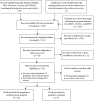Effects of underlying morbidities on the occurrence of deaths in COVID-19 patients: A systematic review and meta-analysis
- PMID: 33110586
- PMCID: PMC7567434
- DOI: 10.7189/jogh.10.020503
Effects of underlying morbidities on the occurrence of deaths in COVID-19 patients: A systematic review and meta-analysis
Abstract
Background: Coronavirus disease 2019 (COVID-19), the most hectic pandemic of the era, is increasing exponentially and taking thousands of lives worldwide. This study aimed to assess the prevalence of pre-existing comorbidities among COVID-19 patients and their mortality risks with each category of pre-existing comorbidity.
Methods: To conduct this systematic review and meta-analysis, Medline, Web of Science, Scopus, and CINAHL databases were searched using pre-specified search strategies. Further searches were conducted using the reference list of the selected studies, renowned preprint servers (eg, medRxiv, bioRxiv, SSRN), and relevant journals' websites. Studies written in the English language included if those were conducted among COVID-19 patients with and without comorbidities and presented survivor vs non-survivor counts or hazard/odds of deaths or survivors with types of pre-existing comorbidities. Comorbidities reported in the selected studies were grouped into eight categories. The pooled likelihoods of deaths in each category were estimated using a fixed or random-effect model, based on the heterogeneity assessment. Publication bias was assessed by visual inspection of the funnel plot asymmetry and Egger's regression test. Trim and Fill method was used if there any publication bias was found.
Results: A total of 41 studies included in this study comprised of 27 670 samples. The most common pre-existing comorbidities in COVID-19 patients were hypertension (39.5%), cardiovascular disease (12.4%), and diabetes (25.2%). The higher likelihood of deaths was found among COVID-19 patients who had pre-existing cardiovascular diseases (odds ratio (OR) = 3.42, 95% confidence interval (CI) = 2.86-4.09), immune and metabolic disorders (OR = 2.46, 95% CI = 2.03-2.85), respiratory diseases (OR = 1.94, 95% CI = 1.72-2.19), cerebrovascular diseases (OR = 4.12, 95% CI = 3.04-5.58), any types of cancers (OR = 2.22, 95% CI = 1.63-3.03), renal (OR = 3.02, 95% CI = 2.60-3.51), and liver diseases (OR = 2.35, 95% CI = 1.50-3.69).
Conclusions: This study provides evidence that COVID-19 patients with pre-existing comorbidities had a higher likelihood of death. These findings could potentially help health care providers to sort out the most susceptible COVID-19 patients by comorbidities, take precautionary measures during hospitalization, assess susceptibility to death, and prioritize their treatment, which could potentially reduce the number of fatalities in COVID-19.
Copyright © 2020 by the Journal of Global Health. All rights reserved.
Conflict of interest statement
Competing interests: The authors completed the ICMJE Unified Competing Interest form (available upon request from the corresponding author), and declare no conflicts of interest.
Figures
References
-
- Centers for Disease Control and Prevention. Coronavirus Disease 2019 (COVID-19), 2020. Available: https://www.cdc.gov/coronavirus/2019-ncov/prepare/transmission.html. Accessed: 20 March 2020.
-
- World Health Organization. WHO Coronavirus Disease (COVID-19) Dashboard, 2020. Available: https://covid19.who.int/. Accessed: 27 July 2020.
-
- Worldmeter. COVID-19 Coronavirus Pandemic (Real time database), 2020. Available: https://www.worldometers.info/coronavirus/. Accessed: 27 July 2020.
Publication types
MeSH terms
LinkOut - more resources
Full Text Sources
Medical

